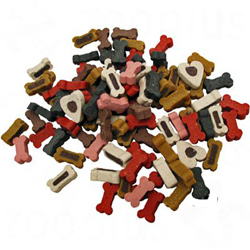The best reward snacks
– Also for Puppies –
Written by Isabel Koutzarov, Owner Big Dog Company
Introduction
Training requires reward snacks, and here too you want to make the best choice. But there is a lot for sale on the market and you can no longer see the forest for the trees. At Big Dog we often get questions about this, so we put it on paper. Read our tips below and of course which reward snacks are the best.
Tip #1: Avoid ''composite'' rewards with unknown content
By composite rewards, we mean reward sweets that do not consist of 100% meat/fish/vegetables or fruit. In itself, a composite candy does not have to be bad, as long as the ingredients of the candy are clear (and not unhealthy). And that is often lacking: the content is only partially known. The example below shows this.
|
RATHER NOT: Grains, meat and animal by-products (min. 10% chicken, min. 4% lamb), fish and fish by-products (min. 4% salmon), vegetable by-products, minerals €9.99 for 1500 grams |
This reward snack consists of ''grains'' (how much, which?), ''meat and animal by-products'' (how much, which?) and ''fish and by-products'' (how much, which?).
Of the meat and animal by-products, 10% is chicken and 4% lamb. So 14% (10% + 4%) has been explained, but what does the other (86%) of the ''meat and animal by-products'' consist of? This also applies to 'fish and fish by-products'. Four percent is salmon, what is the other 96%?
In this case, it is largely unclear what is in these snacks. Would you like to give this to your four-legged friend?
Tip #2: Pay attention to (artificial) colors and fragrances
The colors of most commercial candies, like in the photo above, look quite artificial. It goes without saying that you want to avoid artificial colors and fragrances. But often these substances are not explicitly mentioned on the packaging.
“If it looks artificial, it probably is”
Tip #3 Bite-swallow-away
Lots of training also means lots of rewards. To control the quantity (literally and figuratively), make sure your reward treats are as small as possible, because if he has to chew for a long time, he can become distracted and forget what he was rewarded for.
So make sure the reward is small. For small breeds and puppies, a snack the size of a quarter of your little fingernail is sufficient as a reward.
But most reward candies are larger, so it is useful to choose candies that are easily breakable so that you can break them with bite-swallow-away trainers.
Tip #4 Dogs have taste too!
If you want to learn something new, choose a (new) fragrant snack. This increases motivation, causing your four-legged friend to pay more attention to you and increase the willingness to perform the exercise properly ("Learn to Earn").
On the other hand, sometimes your dog becomes overstimulated and distracted because the snack too tasty. All he wants is that snack, he can't hold back and he can't execute the command. In this case, choose a less tasty snack.
When your dog has mastered the basic commands, for example 'sit' and 'down', choose a less tasty snack and reward him less often for these exercises. This way, the extra tasty snacks remain exciting and you can use them when necessary.
Tip #5 Your puppy only grows once!
A puppy only grows once, and he does this in the first 6-7 months of his life, especially in the period where training is so important. But feeding rewards is not the same as the food itself. The reward snacks do not contain all the nutrients, vitamins and minerals that your puppy needs. Feeding these treats can be detrimental to the absorption of the food. So you are not supposed to give less food so that you can train more. Then your puppy will quickly lack nutritional value.
During the first few months, puppies like almost everything, and if all goes well, they also like their chunks. So why not train with their own chunks?
During the first few months you feed 3-4 meals a day. So you can also use one of the meal chunks as reward snacks. Even if your dog is on raw food, you can replace a meal with (a good) chunk. Does your dog eat chunks? Then you can also choose another puppy food with a different taste.
This way you prevent your puppy from consuming too much food/snacks and from the body preferring the substances from the snacks to the food. This way your puppy will grow as it should during the first few months!
Which reward sweets am I a fan of?
On our website we have a category 'training snacks' where the best training snacks are listed. Some extras:
- Small, (good) puppy food - For example Essentials '' the Beginning Small Breed' '. Made with a high proportion of fresh and dried meat, these chunks are very tasty for most dogs.
- The Riverwood Grill snacks or Carnilove Meat Jerky : These are strips of approximately 7 cm long, flexible and easy to break into small pieces for the optimal snack. There are 5 flavors available.
- Mini snacks : these are small pieces of about one centimeter of 100% of the chosen animal species. Because they are soft, they are easy to break into smaller pieces. There are 5 flavors, duck, deer, rabbit, lamb and beef
- Salmon cookies: made from 100% salmon. The one and a half cm cookies are easy to break.
- Eden semi-moist duck and tripe : small pillow-shaped chunks. Their scent has quickly made them a favorite among dogs. Soft enough to break into smaller pieces.
- Mini Trainers Beef Lung and Chicken : crispy snacks, so difficult to break, but small enough for larger breeds/older puppies to train with.




